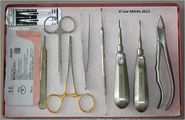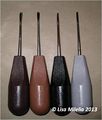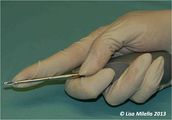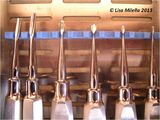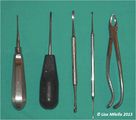Dental Extraction Hand Instruments - Small Animal
Introduction
Hand instruments required for tooth extraction include a selection of luxators and elevators, periosteal elevators, extraction forceps and a small surgical kit (scalpel blade, forceps, suturing instruments and suturing material).
Luxators and Elevators
Luxators and elevators are used to cut or break down the periodontal ligament, which holds the tooth in the alveolus. A selection of dental luxators and elevators of varying sizes are required so that an appropriate range for each size of root is available.
Luxators have a very thin working end and are used to cut the gingival attachment and periodontal ligament, but should not be used for leverage as the metal at the tip is too thin and weak for this action.
Elevators have thicker working ends. They are used to break down the periodontal ligament with a combination of apical pressure and leverage. The tip of an elevator should form a sharp edge which can be rounded or square. Modified ends such winged elevators have extended sides and are also available.
An extraction can be started with a luxator and completed with an elevator.
A very small (2 mm) luxator, or a root tip elevator, will assist removal of fractured root tips and should be available for all extractions – just in case.
Periosteal Elevator:
A periosteal elevator is required for open (surgical) extractions to expose the alveolar bone by raising a mucoperiosteal flap. Different patterns are available but all have a spoon-like blade in line with the handle. The working side is flat with a concave curvature and the back side is rounded. The edge should be sharp and will need regular sharpening as it is used against bone.
Extraction Forceps:
Forceps are used to aid ligament breakdown by rotational force on the tooth. It is easy to snap the crown off by using excessive force or if the tooth is not levered sufficiently.
The forceps should grip the tooth firmly with four point contact. The best pattern for veterinary use is 76 and 76N. The pattern is almost straight with a slight offset of the beaks. The 76N has the same profile but with narrower beaks and is used to grip smaller teeth, for example cat teeth.
Scalpel Blade
The use of a scalpel blade to free the gingival attachment to the tooth is recommended for both closed and open extraction technique. A size 15 or 11 blade, used in the handle, is ideal.
Suture Kit and Suture Material
A suture kit with small (ophthalmic) instruments should be available. An absorbable suture material should always be used in the oral cavity. Monocryl® (polyglecaprone, Ethicon) makes a good choice of material.
| This article was written by Lisa Milella BVSc DipEVDC MRCVS. Date reviewed: 13 August 2014 |
| Dental Extraction Hand Instruments - Small Animal Learning Resources | |
|---|---|
To reach the Vetstream content, please select |
Canis, Felis, Lapis or Equis |
| Endorsed by WALTHAM®, a leading authority in companion animal nutrition and wellbeing for over 50 years and the science institute for Mars Petcare. |
Error in widget FBRecommend: unable to write file /var/www/wikivet.net/extensions/Widgets/compiled_templates/wrt696bcdc730c206_19652360 Error in widget google+: unable to write file /var/www/wikivet.net/extensions/Widgets/compiled_templates/wrt696bcdc737a754_54117901 Error in widget TwitterTweet: unable to write file /var/www/wikivet.net/extensions/Widgets/compiled_templates/wrt696bcdc73ec856_92328158
|
| WikiVet® Introduction - Help WikiVet - Report a Problem |
